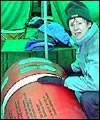HIGH ALTITUDE ILLNESS
Rapid ascent to altitude, without allowing the body time to acclimatize, can cause several illnesses. They all occur within the first few days of ascent and respond to descent. Prevention, with a slow-graded ascent is the key. Current guidelines suggest avoiding abrupt ascent to sleeping elevation of more than 3000m. Spend two to three nights at 3000m and then allow an extra night for acclimatization every 600 to 900m. Avoid abrupt increases of more than a 600m in sleeping elevation per day. The old climber saying "climb high, sleep low" is good advice - day climb to a higher elevation and then return lower for sleep.
Mild exercise will help the body adjust to higher altitude. However, keep in mind that overexertion will contribute to altitude illness. This idea of slow ascent is why we took almost two weeks to trek from Namche (3400m) to Everest Base Camp (5300m). On the trek up, no one had any more than mild altitude problems.
Acute Mountain Sickness (AMS):
The severity of AMS depends on altitude, rate of ascent, length of exposure, exertion and individual physiology. AMS is generally not all that significant, but it can progress to more serious forms of altitude illness. AMS produces headache, dizziness, fatigue, loss of appetite, and nausea. These symptoms are often described as similar to a hangover. This problem is usually seen with a rapid ascent of more than 1000m, although it can occur with less elevation gain.
Successful treatment is based on early detection. The most basic treatment is to stop ascent. This allows time for the body to acclimatize, and may take several days. If symptoms continue to worsen, then DESCEND. Acetazolimide (Diamox) can help speed acclimatization and therefore can improve symptoms if given early. The most accepted dose is 125mg twice a day. Symptomatic treatment with over-the-counter medications for headache or nausea are okay, as long as you don't go higher. Also, sedatives, such as alcohol, antihistamines or sleep aids, should be avoided. The best treatment is descent. The general rule is descend until the symptoms are gone, usually about 500 to 1000m. Another possible treatment is with a portable hyperbaric chamber (commonly known as GAMOW or PAC bags). These inflatable chambers simulate descent by increasing the air pressure inside.
High Altitude Cerebral Edema (HACE):
It is probably easiest to think of altitude illness as a spectrum, with AMS on the mild side and progressing to HACE on the serious side. HACE is basically extreme AMS. It is caused by swelling of the brain. The main signs of HACE are ataxia (walking like a drunk) and altered consciousness (drowsy, confused, stupor or coma). Headache and vomiting are also often present. The progression from mild AMS to coma can be as fast as 12 hours, but usually takes several days.
Treatment again depends on early recognition. At the first signs of ataxia, or altered consciousness, DESCEND, DESCEND, DESCEND! The drug Dexamethasone (Decadron) should also be started with an 8mg injection, or orally, then 4mg every six hours. Oxygen is also helpful if available.
High Altitude Pulmonary Edema (HAPE):
This is the illness made famous recently in Vertical Limit (although they didn't get it quite right)!
This is the most common cause of death due to altitude. Again, this is easily treatable if recognized early. Basically, HAPE is caused by the blood vessels in the lungs leaking fluid into the air spaces and the lungs filling with fluid. This obviously causes problems with breathing!
The earliest signs are decreased exercise tolerance and increased recovery time. Signs of AMS are often present as well. Initially, a persistent dry cough often develops, and nailbeds and lips become a blue/gray color (known as cyanosis). As the illness progresses, shortness of breath at rest and audible crackles in the lungs develop. This is serious. Often, if the patient lies down they become more short of breath. Frothy sputum, often blood tinged, is a very late finding and very bad. The illness may then progress to mental changes, ataxia and coma (HACE). More than half of the victims with HAPE also develop HACE.
Successful treatment, as always, depends on early recognition, and on DESCENT. However, because exertion worsens the condition, exercise must be minimized. Oxygen immediately improves the situation. If descent is not possible, oxygen may be lifesaving and should be the highest priority. Drugs are of limited value in treating HAPE. The drug Nifedipine (Adalat XL) has proven effective - 30 mg every 12 hours orally. However, improvement is much better with descent and oxygen than with any drug.
The treatment given "Dex" in Vertical Limit was not medically correct. Neither was the discoloration of the victim's chest wall. To the filmmaker's defense, HAPE did make for a very dramatic and time-dependent problem. Plus, injections and needles are always much more dramatic than swallowing a pill. Ah, Hollywood.
OTHER HIGH ALTITUDE SYNDROMES:
High Altitude Bronchitis:
This is most commonly known as the "Khumbu Cough." Sore throat and chronic cough afflict almost all of us who spend more than two weeks at Base Camp or above. This problem is not necessarily a sign of infection or HAPE (although I keep a close eye).
The big problem is the increase in breathing, often through the mouth, which means air is not being moisturized in the nose. The cold, dry air irritates the throat and breathing passages and causes a dry, hacking cough. Exertion makes this problem worse, which is a problem when you're trying to climb the highest mountain in the world. This can actually become severe enough to crack ribs due to coughing and this is not rare.
Basically, the only cure is descent, although we try all sorts of tricks, from codeine to cough candies, to sleeping with masks.
High Altitude Flatus Expulsion (HAFE):
This is the bane of all tentmates! It is a serious syndrome, listed in any good altitude textbook... I am not making this up! This problem is caused by the expansion of bowel gas as one increases in altitude (Boyle's Law explains this. Remember high school physics?). This results in the unwelcome passage of colonic gas (translation - you fart lots). Many a tentmate have been put off by this affliction!
— Bryce Brown, Alpine Ascents International Expedition Doctor and MountainZone.com Correspondent
 EMAIL THIS STORY TO A FRIEND
EMAIL THIS STORY TO A FRIEND




